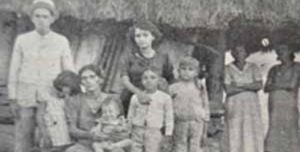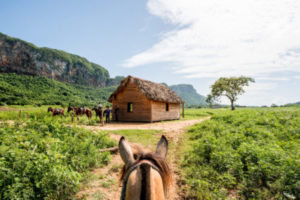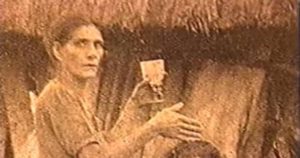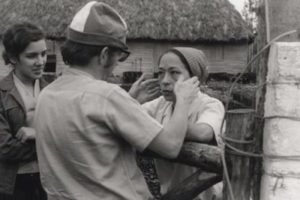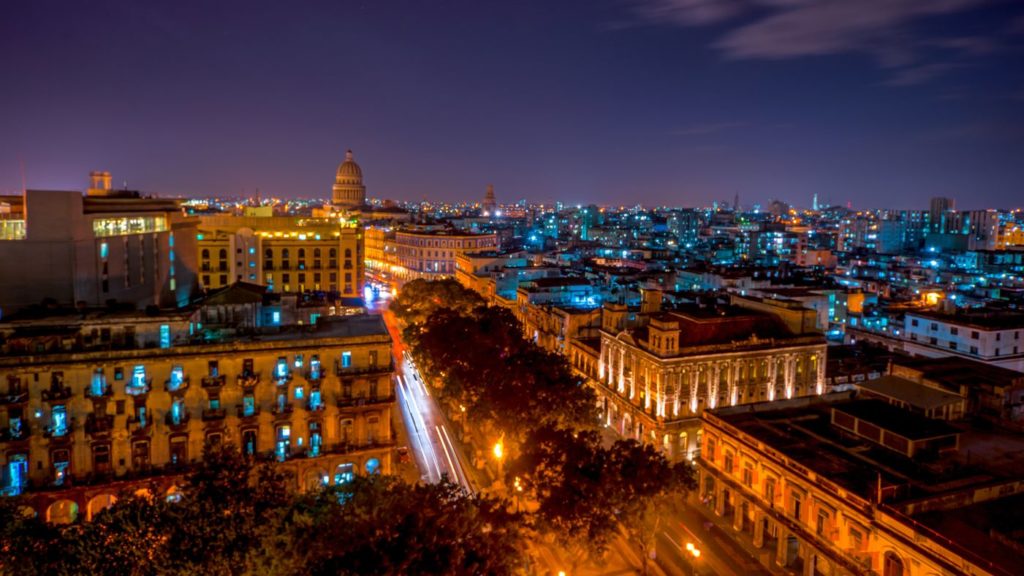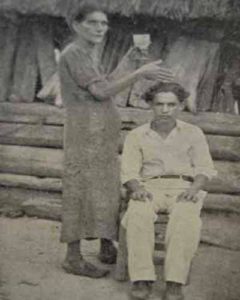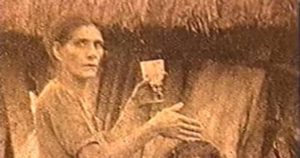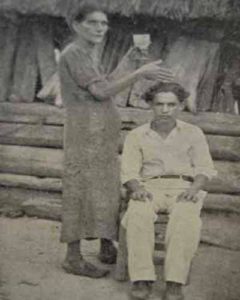 LA HISTORIA DE ANTOÑICA IZQUIERDO LA “MILAGRERA” DE PINAR DEL RIO.
LA HISTORIA DE ANTOÑICA IZQUIERDO LA “MILAGRERA” DE PINAR DEL RIO.
Tambien conocida como “La Virgen de los Cayos”, Antoñica Izquierdo, la sexta de trece hijos de inmigrantes canarios residentes en la zona de los Cayos de San Felipe, nació en la finca ‘Las Ayudas’ en 1899, en el municipio Viñales, Provincia de Pinar del Rio.
Su religiosidad era una especie de catolicismo mezclado con espiritismo. En 1915 se casó con un vecino tabacalero con quien tuvo siete hijos. Se consideró destinada por Dios como su mensajera y tutelada por la Virgen María para ayudar a la gente, a la humanidad. Siempre repetía: “La fe en Dios es la que cura”.
Era la típica campesina pobre con el peso del hogar a sus espaldas, integrado por su esposo y sus siete hijos. Flaca, con los pies curtidos por la desnudez, el pelo negro y desaliñado recogido en un moño a la altura de la nuca, vestía siempre una túnica larga hasta los tobillos.
Mujer analfabeta que no sabía ni su edad, pero nunca perdía la ternura ni el trato solidario hacia los demás, la engrandecía su espiritualidad.
COMIENZA SU VIDA COMO “MILAGRERA”.
La madrugada del 8 de enero de 1936 su hijo menor enfermó con fiebres muy altas. En medio de la impotencia sin dinero para médicos ni medicinas y agotados todos los remedios caseros que conocía, Antoñica, desesperada, aseguró haber escuchado la voz de la Virgen que le decía que no se preocupara, que su hijo no moriría, y le recomendó un modo de curarlo con agua.
El enfermo sanó y ese fue el nacimiento de un fenómeno de religiosidad popular y de una leyenda. A partir de ese día comenzó a crecer el mito de Antoñica Izquierdo.
Se dice que posteriormente tuvo otra revelación de la Virgen en el que le daba a la pinareña el don de sanar con agua “Te voy a facultar para que puedas curar, pero nunca podrás cobrar a nadie ni hacerlo por interés”.
Caravanas de a pie, a caballo, en carreta, largas filas de creyentes venían de todas partes de Cuba. Se concentraban en las cercanías de su humilde bohío ahora convertido en santuario.
Esperaban de cinco a seis días para ser sanados por el agua de Antoñica que veían como una santa por sus milagros y su condición campesina, hasta cambiaban la consulta médica ordinaria por sus curas con agua.
Desde el amanecer hasta caer la noche, casi sin poder sostenerse del cansancio, el hambre y la sed, la lugareña atendía a los necesitados, con una palangana llena de agua rociaba con una mano a los enfermos por la cabeza, varias veces, al tiempo que repetía: “Perro maldito a los infiernos”, haciendo una cruz con los dedos en el aire.
Antoñica asumía que no solo curaba males físicos sino también dolencias espirituales y salvaba a pecadores.
Junto a la sanación, Antoñica proponía un modo de resistencia cívica, pacífica, a través de una pasividad y abstención que no violara las leyes del Estado, pero prohibiendo a sus adeptos la inscripción en censos electorales y votar, amenazando a quienes lo hicieran con que el Diablo se apoderaría de sus almas. Con todas estas prédicas, juntó una masa de fieles que a los ojos de los campesinos la hacían una auténtica líder.
Su fama despertó despecho y miedo entre los afectados en sus negocios, los boticarios, los médicos, los políticos que no pudieron manipularla y el 14 de abril de 1936 fue acusada de ejercer ilegalmente la medicina.
Le abrieron una causa judicial en el Juzgado Correccional de Viñales. El juicio se celebró el 15, pero fue absuelta al no poder demostrarse la infracción imputada.
Su hermana la llevó a su casa en el poblado ‘Isabel María’, donde la milagrera continuó su misión rodeada de un clima de paz que duró poco.
Con los comicios de 1944, los políticos de la localidad la volvieron a acusar de obstruir las elecciones. La trasladaron a Consolación del Sur y celebraron un nuevo juicio, ahora por el delito de coacción a los electores, a quienes convencía de no votar, porque la política, según ella, era cosa del Diablo.
A finales de ese año decidieron llevarla a Pinar del Río donde la Audiencia promovió un expediente en su contra por presentar síntomas de demencia, proceso que terminó con la reclusión de Antoñica en el Hospital de Mazorra, donde murió el 1º de marzo de 1945 con un diagnóstico de demencia.
Uno de sus pacientes sanados en milagro, fue el hijo de Félix Rodríguez Paula, el campesino que luego fundara “la secta de los acuáticos”, quien impactado por la cura de su primogénito, se internó con su familia en un paraje de la sierra de Viñales.
Desde entonces, sus descendientes conviven sobre la base de las curas con agua de un manantial cercano y las prédicas de Antoñica Izquierdo.
En 1971, se produjo por el ICAIC el filme Los días del agua, del director Manuel Octavio Gómez, que a su modo rememora los acontecimientos alrededor de este legendario personaje.
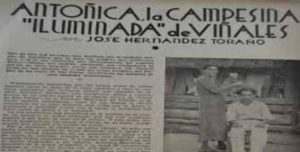 THE ANTOÑICA IZQUIERDO STORY “LA MILAGRERA” FROM PINAR DEL RIO.
THE ANTOÑICA IZQUIERDO STORY “LA MILAGRERA” FROM PINAR DEL RIO.
Also known as “La Virgen de los Cayos”, Antoñica Izquierdo, the sixth of thirteen children of Canarian immigrants residing in the Cayos de San Felipe area, was born on the ‘Las Ayudas’ farm in 1899, in the Viñales municipality, Pinar del Rio Province.
His religiosity was a kind of Catholicism mixed with spiritism. In 1915 she married a tobacco neighbor with whom she had seven children. She considered herself destined by God as his messenger and supervised by the Virgin Mary to help people, humanity. He always repeated: “Faith in God is the one that cures”.
She was the typical poor peasant with the weight of the home behind her, made up of her husband and seven children. Skinny, with her feet tanned by nudity, her scruffy black hair tied back in a bun at the nape of her neck, she always wore an ankle-length tunic.
An illiterate woman who did not even know her age, but never lost tenderness or solidarity towards others, her spirituality enhanced her.
On the morning of January 8, 1936, her youngest son fell ill with very high fevers. In the midst of helplessness without money for doctors or medicines and exhausted all the home remedies she knew, Antoñica, desperate, claimed to have heard the voice of the Virgin saying to her not to worry, that her son would not die, and recommended a way to cure it with water.
The patient was healed and that was the birth of a phenomenon of popular religiosity and a legend. From that day on, the myth of Antoñica Izquierdo began to grow.
It is said that he subsequently had another revelation of the Virgin in which he gave the person from Pinar del Río the gift of healing with water “I am going to empower you so that you can heal, but you can never charge anyone or do it for interest.”
Caravans on foot, on horseback, in a wagon, long lines of believers came from all over Cuba. They concentrated in the vicinity of their humble hut now converted into a sanctuary.
They waited for five to six days to be healed by the Antoñica water that they saw as a saint because of her miracles and her peasant condition until they exchanged the ordinary medical consultation for her cures with water.
From dawn until nightfall, almost unable to sustain herself from tiredness, hunger, and thirst, the local woman cared for the needy, with a basin full of water, sprinkled the sick on the head with several hands, at the same time that he repeated: “Dog cursed to hell”, making a cross with his fingers in the air.
Antoñica assumed that he not only cured physical ills but also spiritual ailments and saved sinners.
Along with the healing, Antoñica proposed a mode of peaceful civic resistance, through passivity and abstention that did not violate state laws, but prohibited its adherents from registering on electoral censuses and voting, threatening those who did so with the Devil would take over their souls. With all these preachings, she gathered a mass of faithful that in the eyes of the peasants made her a true leader.
Her fame aroused spite and fear among those affected in her businesses, the apothecaries, the doctors, the politicians who could not manipulate her and on April 14, 1936, she was accused of illegally practicing medicine
They opened a judicial case in the Viñales Correctional Court. The trial was held on the 15th, but it was acquitted as the imputed infraction could not be demonstrated.
Her sister took her to her house in the village ‘Isabel María’, where the miracle worker continued her mission surrounded by a climate of peace that was short-lived.
With the 1944 elections, the local politicians again accused her of obstructing the elections. They transferred her to Consolación del Sur and held a new trial, now for the crime of coercion of the voters, whom she convinced not to vote, because politics, according to her, was a thing of the Devil.
At the end of that year, they decided to take her to Pinar del Río where the Court promoted a file against her for presenting symptoms of dementia, a process that ended with the confinement of Antoñica in the Mazorra Hospital, where she died on March 1, 1945, with a dementia diagnosis.
One of his patients healed in a miracle was the son of Félix Rodríguez Paula, the peasant who later founded “the sect of the aquatic”, who, shocked by the cure of his first-born, went to his family in a place in the Sierra de Viñales.
Since then, their descendants have lived together on the basis of cures with water from a nearby spring and the preaching of Antoñica Izquierdo.
In 1971, the film Los Días del Agua, by director Manuel Octavio Gómez, was produced by ICAIC, which in its own way recalls the events around this legendary character.
Agencies/ Wiki/ Various/ Maria Calvo/ Internet Photos/ Arnoldo Varona/ www.TheCubanHistory.com
THE CUBAN HISTORY, HOLLYWOOD.



